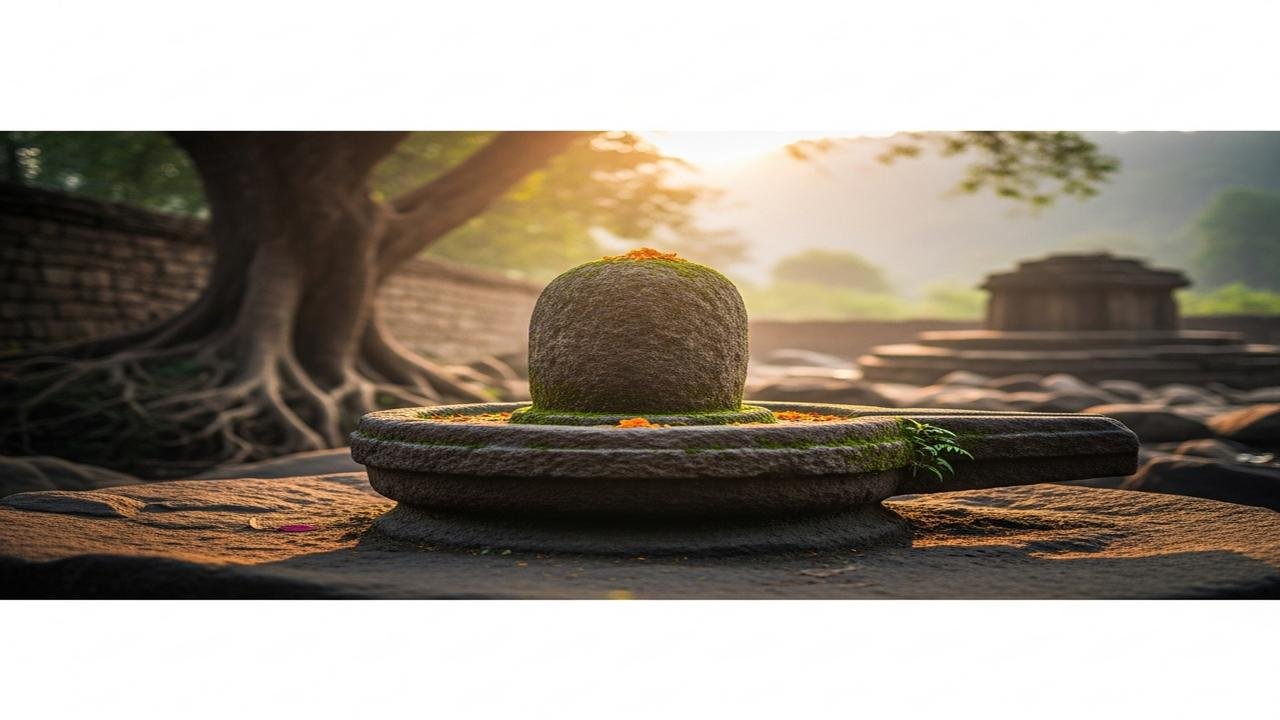Linga: Meaning, Ritual Role and Swayambhu Lingas

What does “linga” mean?
The Sanskrit word linga (लिङ्ग) literally means a “mark” or “sign.” In Hindu traditions the term came to denote a simple, aniconic emblem used to represent Lord Shiva. Rather than being a detailed anthropomorphic statue, the linga functions as a focal sign — a visible pointer to an otherwise formless reality.
Historical and textual background
References to Shiva’s power and to Rudra-like figures appear already in the Vedas, but the specific cult of the linga develops more clearly in early medieval texts. The Linga Purana and sections of the Shiva Purana contain the famous lingodbhava story: Brahma and Vishnu seek the limits of an infinite pillar of light (the linga) that reveals Shiva’s boundless nature. Medieval Agamic manuals (Shaiva temple texts) elaborate ritual details and classification of lingas.
Archaeological discussions (for example about certain Indus Valley motifs) are contested; scholars differ on continuity claims. In the colonial period many European writers interpreted the linga as essentially phallic; Indian scholars and many modern historians emphasize a broader symbolic and theological range of meanings.
Key theological readings
- Śaiva explanations: In many Shaiva schools the linga is both immanent and transcendent — a manifest sign of an unmanifest Lord. Shaiva Agamas present categories such as the self-manifested swayambhu linga (said to appear naturally) and lingas installed ritually. Philosophical texts also distinguish levels: a gross (sthula) linga, a subtle (sukshma) linga, and a causal (karana) linga, indicating stages of reality.
- Vedantic and Smārta readings: Some Advaita Vedanta and Smarta interpreters treat the linga as a helpful symbol to concentrate the mind on nirguna (attribute-less) Brahman. The linga here is not an end in itself but a device for meditation and devotion.
- Śākta perspectives: Shakta traditions often emphasize the linga–yoni pairing (linga as Shiva, yoni as Shakti) to express creative union. Many tantric-influenced practices focus on energy and cosmic processes rather than crude sexuality.
- Popular devotional readings: For most temple-going devotees the linga is a sacred centre of worship — the locus where offerings, ritual baths and mantras are directed to receive blessing and to cultivate bhakti (devotion).
Why an abstract sign rather than an image?
Several interlocking reasons explain the predominance of the linga in Shiva worship:
- Philosophical avoidance of limiting God: A pillar-like or aniconic form resists tying the divine to a single human shape and thus gestures to the infinite.
- Ease of ritual focus: Simple forms are practical and accessible for domestic and temple rites, allowing wide participation.
- Symbolic density: The linga can simultaneously signify creation, preservation and dissolution; it can stand for male principle, cosmic consciousness, or simply a sign of the Absolute depending on context.
- Regional and historical variation: The shape and treatment of lingas vary across time and place — river stones (banalinga), carved stone pillars, metal icons — reflecting local devotion and resources.
Ritual role in temples and homes
The linga usually occupies the sanctum (garbhagriha) of Shiva temples. Typical practices include ritual bathing (abhisheka) with water, milk, curd, honey and other items; offering bilva (bel) leaves; and recitation of mantras and hymns. These actions are meant to honour and to focus the worshipper’s attention on Shiva’s presence. The linga often rests in a base called a yoni (literally “womb” or “source”), and the united linga–yoni is read by many traditions as the cosmic creative interplay of Shiva and Shakti.
Common practical forms
- Swayambhu: naturally occurring lingas, revered as self-manifested.
- Banalinga: smooth river stones shaped by nature (popular in some home shrines).
- Installed (pratishta): ritually consecrated lingas in temples.
Contested readings and modern debates
Scholars and practitioners continue to debate emphases. The colonial-era phallic interpretation provoked defensive responses from Indian reformers and theologians, who highlighted metaphysical, devotional and ritual meanings instead of a purely sexual reading. Contemporary historians tend to treat multiple layers of meaning as plausible: phallic imagery may be one strand in a larger web of symbolism, but it is not the only or necessarily the dominant understanding within indigenous traditions.
Why devotees worship the linga
- As a practical aid to concentration and meditation: a visible sign helps focus attention toward the divine.
- As a symbol of the cosmic principle: the linga can represent Shiva as both immanent presence and transcendent Absolute.
- As the centre of communal and domestic ritual: shared rites build identity and continuity across generations.
- As a relationship of devotion: for many, worship is direct and heartfelt rather than primarily doctrinal.
Closing note
The linga is thus a multilayered sign. In Śaiva texts it is a revealing gesture to what cannot be circumscribed; in popular devotion it is a beloved focus for ritual and prayer; in academic discussion it is a subject of historical and symbolic analysis. Different schools emphasise different aspects — metaphysical, devotional, tantric, or social — and those differences are part of the living pluralism of Hindu practice.
Health note: Ritual practices such as lengthy fasts, extreme breath-control techniques or prolonged physical austerities can affect health. Seek qualified guidance and consult a healthcare professional before undertaking intense practices.
